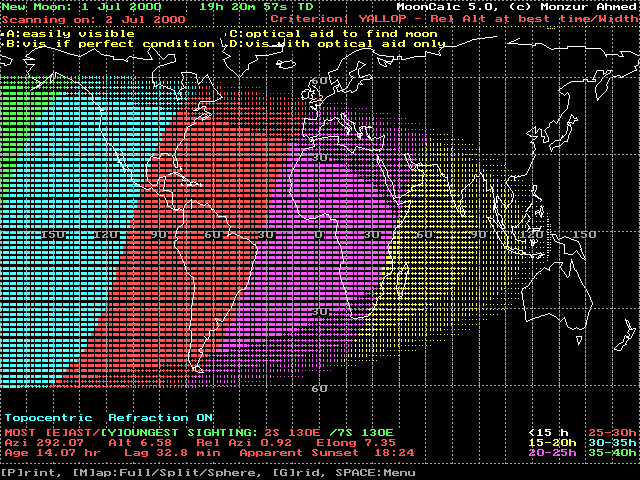
Visibility of Rabea' Thani Crescent
(1421 AH)

In this page:-
- When to Observe ?
- Observing the Crescent
- The OFFICIAL First Day in Different Countries
- The Accuracy of The Astronomical Calculations.
The geocentric new Moon will occur on Saturday 01 July 2000, at 19:20 UT. On this day (01 July), the crescent will NOT be seen from anywhere on Earth. While on the next day (02 July), the program Moon Calculator by Dr. Monzur Ahmed -according to Yallop criterion- showed that the crescent is expected to be seen by telescopes in the eastern parts of the world, while it could be seen by naked eyes in less eastern parts in the world, such as Africa and the Middle East. However, the crescent is not expected to be seen on this day (02 July) from Australia, and the northern parts of Asia and Europe. Consequently, arrange to observe the crescent after the sunset of 02 or 03 July. Kindly click on the below icon to see the visibility parabola as plotted by the program Moon Calculator

When to Observe ?

Results of seeing the crescent, and the first day of Rabea' Thani in different countries will be added here Inshalla as we receive the reports from ICOP's members. If you wish to be a member in ICOP, or to know more about it, kindly click here.
So far, the earliest sighting of the crescent was on 02 July from Malaysia by Mr. Kassim Bahali (KUSZA Astronomical Unit). The crescent was also seen on 02 July from Jordan, South Africa, and USA.
Sunday 02 July
Jordan:
- Longitude: 35:30 E
With great thanks Al-Ittihad Schools offered us one of their busses to go to the location of observation. The driver, Mr. Fayez Ash-Sharif was so cooperative, and we reached the location around 18 local time. We did visit Ash-Shoubak several times, and were fond of its marvelous nature! And its clear skies! However, this time the western horizon was rather hazy!! Which surprised us! Well, we said to each other "We bet, it is still better than Amman :-)!". We mounted the LX200 10" telescope, and we did two-star alignment at daytime! It was so interesting to see the stars at daytime :-)! And we did see Venus as well! We entered the coordinates of the crescent, and the telescope moved automatically to the entered coordinates. However, so far no crescent was seen!
At 19:42 when the Sun was still visible Katbeh said I can see the crescent! I looked in the eyepiece, and I noticed something! But as for me I can't confirm it was the crescent. But Tareq did believe it was the crescent. The Sun disappeared among the haze somehow around 19:47. Later on at 19:53 I did see the crescent through the telescope with considerable difficulty. All the observers could see the crescent via the telescope after that. But none of us was able to see the crescent by either binoculars or naked eyes, although it was expected to see the crescent by naked eyes under perfect atmospheric conditions. But for sure it was not perfect conditions at all!
The observers were:-
The crescent conditions (when firstly seen):-
Palestine: Eng. Ayman Tirhi of PAS said: " I tried to observe the new crescent from the roof of my house in
Jerusalem with my wife (Eng. Samah), but we did not manage to see it
because there were a lot of clouds in the sky."
Mondauy 03 July
Sunday 02 July (Wrong in ALL countries. No crescent visible anywhere!):-
Monday 03 July:-
Tuesday 04 July:-
To know about the accuracy of the astronomical calculations, then please click here

Observing the Crescent
- Latitude: 30:24 N
- Elevation: 1646 m
- Time Zone: +3:00

The OFFICIAL First Day in Different Countries

The Accuracy of The Astronomical Calculations





